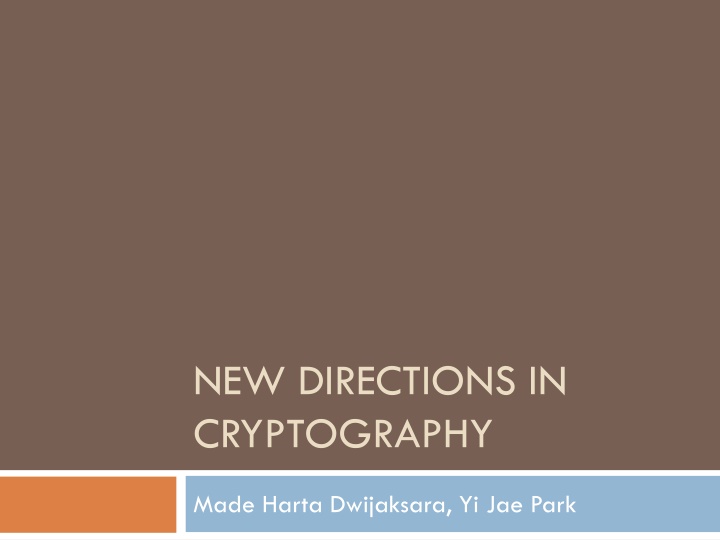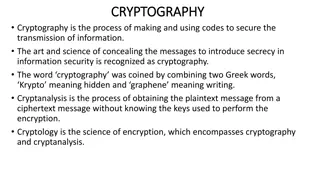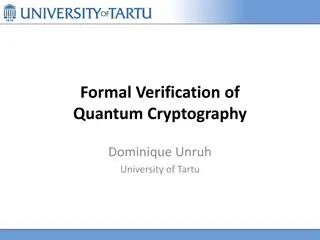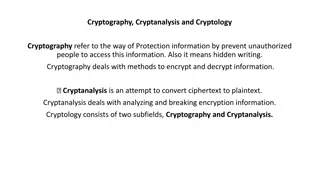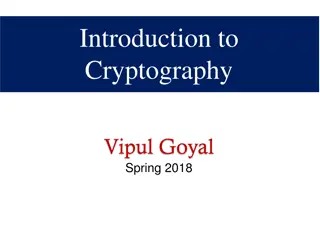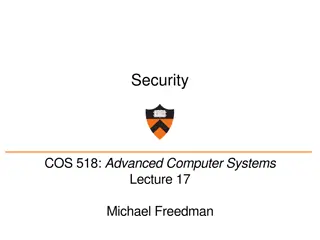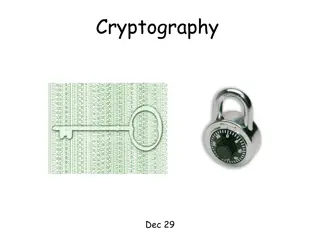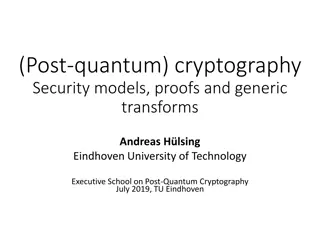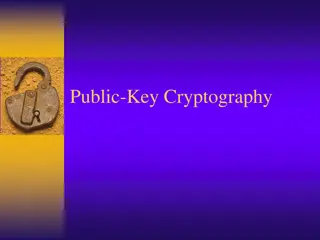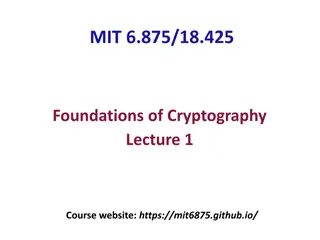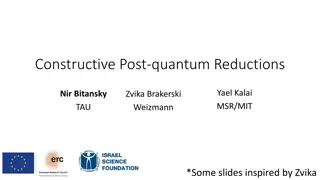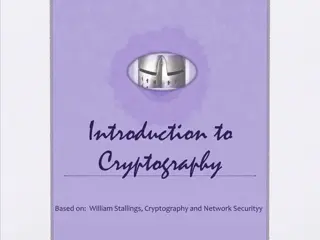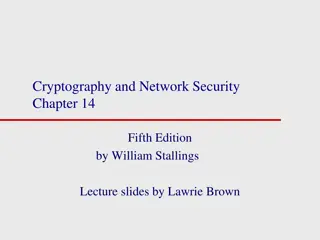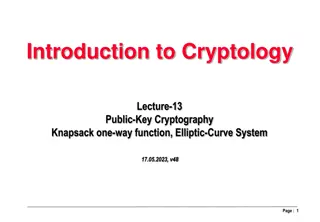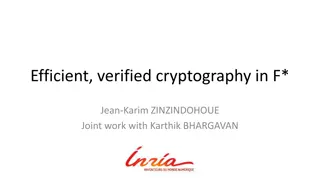New Directions in Cryptography: Harta Dwijaksara, Yi Jae Park
Explore the world of cryptography through this comprehensive guide covering topics such as conventional cryptography, public key cryptography, one-way authentication, trap doors, computational complexity, and more. Learn about the importance of privacy in communications and the key principles behind symmetric-key and public key algorithms. Delve into the challenges and security considerations in cryptography highlighted in this informative resource.
Download Presentation

Please find below an Image/Link to download the presentation.
The content on the website is provided AS IS for your information and personal use only. It may not be sold, licensed, or shared on other websites without obtaining consent from the author.If you encounter any issues during the download, it is possible that the publisher has removed the file from their server.
You are allowed to download the files provided on this website for personal or commercial use, subject to the condition that they are used lawfully. All files are the property of their respective owners.
The content on the website is provided AS IS for your information and personal use only. It may not be sold, licensed, or shared on other websites without obtaining consent from the author.
E N D
Presentation Transcript
NEW DIRECTIONS IN CRYPTOGRAPHY Made Harta Dwijaksara, Yi Jae Park
Contents Introduction Conventional Cryptography Public Key Cryptography One-Way Authentication Problem Interrelations Problem Trap Doors Computational Complexity Q&A
Introduction The best known cryptographic problem is that of privacy: preventing the unauthorized extraction of information from communications over an insecure channel
Conventional Cryptography (1/2) Symmetric-key algorithms Encipher: transmitter generates a plaintext P, produces the ciphertext C, C=SK(P) The key K is transmitted only to the legitimate receiver via a secure channel Decipher: receiver decipher C by operating: SK-1(C)=SK-1(SK(P))=P P CRYPTANALYST P=SK -1(C) P MESSAGE SOURCE TRANSMITTER RECEIVER C=SK(P) K KEY SOURCE
Conventional Cryptography (2/2) Computationally secure Unconditionally secure: one time pad(OTP) Computationally infeasible Threats Ciphertext Only Attack Known Plaintext Attack Chosen Plaintext Attack (IFF attack)
Public Key Cryptography (1/4) Symmetric key algorithm has some problems => Public key cryptography P CRYPTANALYST P P MESSAGE SOURCE TRANSMITTER RECEIVER KEY KEY SOURCE #2 SOURCE #1 Flow of information in public key system
Public Key Cryptography (2/4) Public key cryptosystem: a pair of families {EK}K {K} and {DK}K {K} of algorithms representing invertible transformations, EK:{M} {M} DK:{M} {M} on a finite message space {M} 1) for every K in {K}, EK is the inverse of DK 2) for every K in {K} and M in {M}, the algorithms EK and DK are easy to compute 3) for almost every K in {K}, each easily computed algorithms equivalent to DK is computational in feasible to derive from EK 4) for every K in {K}, it is feasible to compute inverse pairs EK and DK form K
Public Key Cryptography (3/4) Concepts Y = aXmod q (1 X q-1) Easy to compute X = logaY mod q (1 Y q-1) Difficult Key exchange Concepts User i place this in public: Yi = aXi mod q Key in Communication between User i and User j (Kij): Kij = aXiXj mod q User i obtains Kij: Kij = YjXi mod q = (aXj)xi mod q = aXjXi = aXiXj mod q User j obtains Kij: Kij = YiXj mod q Other User can obtains Kijby Kij = Yi(logaYj)mod q . But.
Public Key Cryptography (4/4) Concepts
One-Way Authentication Authentication is at the heart of any system involving contracts and billing It must be easy for anyone to recognize the signature as authentic, but impossible for anyone other than the legitimate signer to produce it Login problem in a multiuser computer system One-way function Public key cryptosystem can be used to produce a true one-way authentication system
Interrelation (1/4) A cryptosystem which is secure against known plaintext attack (KPA) can be used to produce a one-way function Take: 1. {SK:{P} {C}}KE{K} secure against KPA 2. Fix P = P0 P0 X Plaintext Key Cipher text Consider: f:{K} {C} defined by f(X) = SX(P0) Y = f(x) Conclusion: This function is one-way because solving for X given f(X) is equivalent to cryptanalytic problem of finding the key from single known plaintext cryptogram pair.
Interrelation (2/4) One-way functions are basic to both block ciphers and key generators A key generator is a pseudorandom bit generator whose output, key stream, is added modulo 2 to message represented in binary form, in imitation of a one-time pad The key is used as seed which determines the pseudorandom key stream sequence key Key 10001010101001 Generator added modulo 2 (XOR) Message 01011110001110 11010100100111
Interrelation (3/4) For the system to be secure, computation of the key from the key stream must be computationally infeasible While, they system to be usable, calculation of the key stream from the key must be computationally simple A good key generator is one-way function
Interrelation (4/4) A public key cryptosystem can be used to generate a one-way authentication Authentication Digital Signature Alice wants to send M to Bob computes C = Dalice s PriK (M) to Bob Bob received message C and Computes Ealice s PubK (C) recover M Then, Bob can used the value of C as a proof that the message come from Alice
Trap Door (1/2) The previous case shows that without information about deciphering key, by knowing only the enciphering key and the message C it is computationally infeasible to find message M As such a public key system is really a set of trap- door one-way functions For such function, only through knowledge of certain trap-door information can one easily find the easily computed inverse
Trap Door (2/2) A trap-door cryptosystem can be used to produce a public key distribution system key plaintext B s trap door cryptosystem B s trap door cryptosystem trap door key Computed cryptogram User B User A
Computational Complexity (1) Neither public key cryptosystem nor one-way authentication system can be unconditionally secure because the public information always determines the secret information uniquely among the member of finite set The cryptosystem is analogous with set mapping from infinite set to finite set (because the use of modulus) With unlimited computation, the problem could therefore be solved by Straightforward search public information secret information
Computational Complexity (2) The cryptanalytic difficulty of a system whose encryption and decryption operations can be done in P(polynomial) time can not be greater than NP (non-deterministic polynomial) Cryptanalytic problem can be solved by finding key, inverse image, etc finite set Choose the key non-deterministically and verify in P time that it is the correct one NP P Since, by assumption, encryption takes only P time the cryptanalysis takes only NP time
Conclusion This paper basically introduces a new away to encrypt/decrypt message Previous way one key is used both for encryption and decryption. New way used different key for encryption and decryption There are two things suggested: Public key system One-way authentication system based on public key
Q&A Thank You!
